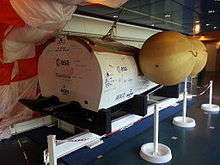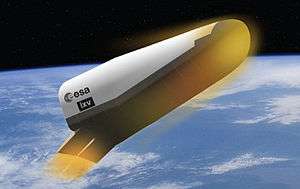Intermediate eXperimental Vehicle
|
Artist's view of IXV reentry phase | |
| Mission type | technology demonstration |
|---|---|
| Operator | ESA |
| Website | ESA Reentry technologies |
| Apogee | 412 km (256 mi) |
| Spacecraft properties | |
| Manufacturer | Thales Alenia Space |
| Launch mass | 1,800 kg (4,000 lb) |
| Start of mission | |
| Launch date | 13:40, February 11, 2015[4][5][6] |
| Rocket | Vega |
| Launch site | Guiana Space Centre ELV |
| End of mission | |
| Recovered by | recovery vessel Nos Aries |
| Landing date | February 11, 2015 |
| Landing site | Pacific Ocean |
The Intermediate eXperimental Vehicle (IXV) is an European Space Agency (ESA) experimental suborbital re-entry vehicle (spaceplane prototype) to validate ESA reusable launchers, evaluated in the frame of the Future Launchers Preparatory Programme (FLPP),[7] and developed under the leadership of the NGL Prime SpA company.[3] The IXV successfully completed its 100-minute[8] mission on 11 February 2015[9] being the first ever lifting body to perform full atmospheric reentry from orbital speed[10]:23
It inherited the principles of previous studies such as CNES's Pre-X and ESA's AREV (Atmospheric Reentry Experimental Vehicle), and the successful Atmospheric Reentry Demonstrator (ARD) flown in 1998. The successor of IXV will be the PRIDE spaceplane (Programme for Reusable In-orbit Demonstrator in Europe).[11]
Design
IXV used a lifting body arrangement with no wings of any sort, using two movable flaps for re-entry flight control. Re-entry was accomplished in a nose-high attitude like the Space Shuttle, with manoeuvring accomplished by rolling out-of-plane and then lifting in that direction, like an aircraft. Landing was accomplished by parachutes ejected through the top of the vehicle. The airframe was based on a traditional hot-structure/cold-structure arrangement, and was supported on-orbit by a separate manoeuvring and support module similar to the Resource Module intended for the Hermes. The avionics were controlled by a LEON2-FT microprocessor, and interconnected by a MIL-STD-1553B serial bus.[12]
On 18 December 2009, ESA announced a contract with Thales Alenia Space valued at €39,400,000 to cover 18 months of preliminary IXV work.[2][13] The total estimated cost for the project is €150,000,000.[1]
Pre-launch testing
The IXV's subsonic parachute system was tested at the Yuma Proving Ground in Arizona in late 2012.[14] Water impact tests were conducted at Consiglio Nazionale delle Ricerche's INSEAN research tank near Rome.[15]
On 21 June 2013 an IXV test vehicle was dropped from an altitude of 3 km (1.9 mi) in the Salto di Quirra range off Sardinia. The test was to validate the water landing system including the subsonic parachute, flotation balloons, and beacon deployment. A small anomaly was encountered when inflating the balloons, but the other systems performed as expected. After the test the vehicle was taken for further analysis.[16]
On 23 June 2014 the recovery ship Nos Aries conducted a training exercise with an IXV test article off the coast of Tuscany.[17]
In June 2014 the IXV test vehicle arrived at the ESTEC Technical Centre in Noordwijk, the Netherlands, to undergo a rigorous test campaign to confirm its flight readiness in anticipation of a flight on a Vega rocket in November.[18]
First reentry test
Originally planned to make its flight in 2013,[19] it was scheduled to perform the launch on 18 November 2014,[20] however this initial launch window was missed due to unresolved range safety concerns.[21] Finally the IXV was launched on 11 February 2015 by a Vega rocket[22] as part of the VV04 mission.[4] Spacecraft launched at 08:40 local time,[23] separated from Vega launch vehicle at 333 km altitude and ascended to 412 km, after which it descended to begin reentry at 120 km altitude with a speed of 7.5 km/s, the same as for Low Earth Orbit spacecraft reentry. Following that IXV glided over Pacific Ocean before opening parachutes to slow down its descent, flying 7300 km from the beginning of the reentry.[10]:25–26 The ESA’s small launcher, descended to the Pacific Ocean for later recovery by the Nos Aries ship, and analysis of the spacecraft and recorded mission data.[24][25]
Follow up mission
After a flawless test flight, ESA officials decided to plan an additional test flight for 2019 or 2020. This time the IXV will land on the ground instead of a splashdown by either installing a parafoil or landing gear. Planning was to begin in March 2015, with design work starting in mid 2015.[26]
Specifications

Data from ESA,[1] Space.com,[19] Gunter's Space Page[3]
General characteristics
- Crew: None
- Capacity: None
- Length: 5 m (16.4 ft)
- Wingspan: 2.2 m (7.2 ft)
- Height: 1.5 m (4.9 ft)
- Empty weight: 480 kg (1,058 lb)
- Loaded weight: 1,900 kg with propulsion module (4,188 lb)
- Power: Batteries
Performance
- Maximum speed: 7700 m/s (27,720 km/h) 17,224 mph
- Range: 7,500 km (4,660 mi)
- Max altitude: 412 km (256 mi) suborbital flight
See also
- 2015 in spaceflight
- Atmospheric Reentry Demonstrator (ARD) - ESA reentry testbed flown in 1998
- European eXPErimental Re-entry Testbed (EXPERT) - research programme developing materials used in IXV
- Future Launchers Preparatory Programme - parent programme for IXV
- Programme for Reusable In-orbit Demonstrator in Europe (PRIDE) - future robotic spaceplane concept which IXV is developed for[26]
- Italian Aerospace Research Centre
- Hopper - an earlier ESA project on developing manned spaceplane, cancelled
- Hyflex (Hypersonic Flight Experiment) - equivalent Japanese spaceplane demonstrator developed and flown by NASDA in 1996
- RLV-TD - Indian reusable technology validation test bed, in development by ISRO
- Aurora programme
References
- 1 2 3 "IXV e-book" (PDF within a ZIP). European Space Agency. 2011. Retrieved 4 November 2011.
- 1 2 de Selding, Peter B. (18 December 2009). "ESA Spending Freeze Ends with Deals for Sentinel Satellites, Ariane 5 Upgrade". Space News. Retrieved 4 November 2011.
The contract is valued at 39.4 million euros to cover preliminary IXV work for 18 months, Fabrizi said.
- 1 2 3 Krebs, Gunter Dirk. "IXV". Retrieved 4 November 2011.
- 1 2 "European space plane set for February launch". News.com.au. News Corp Australia. 22 November 2014. Retrieved 20 January 2015.
- ↑ "European space plane set for February launch: firm". 21 November 2014. Retrieved 24 November 2014.
- ↑ "Worldwide launch schedule". 18 November 2014. Retrieved 19 November 2014.
- ↑ "New milestone in IXV development". ESA. 15 September 2010. Retrieved 4 November 2011.
The Intermediate eXperimental Vehicle (IXV), under ESA’s Future Launchers Preparatory Programme (FLPP), is the step forward from the successful Atmospheric Reentry Demonstrator flight in 1998, establishing Europe’s role in this field.
- ↑ "IXV Mission Timeline". ESA. 9 February 2015. Retrieved 11 February 2015.
It will navigate through the atmosphere within its reentry corridor before descending, slowed by a multistage parachute, for a safe splashdown in the Pacific Ocean some 100 minutes after liftoff.
- ↑ "ESA experimental spaceplane completes research flight". ESA. 11 February 2015. Retrieved 12 February 2015.
ESA’s Intermediate eXperimental Vehicle flew a flawless reentry and splashed down in the Pacific Ocean just west of the Galapagos islands.
- 1 2 "ESA Bulletin 161 (1st quarter 2015)" (PDF). ESA. 2015. ISSN 0376-4265. Retrieved 30 May 2015.
- ↑ Chris Bergin (2015-02-24). "IXV's Pride: Europe's spaceplane homecoming prelude to future goals". NASA SpaceFlight. Retrieved 2015-02-25.
ESA leaders have already authorised development to begin on the IXV’s successor: the Programme for Reusable In-orbit Demonstrator in Europe, or PRIDE.
- ↑ Rodríguez, Enrique; Giménez, Pablo; de Miguel, Ignacio; Fernández, Vicente (25 September 2012). SCOE for IXV GNC. Simulation & EGSE Facilities for Space Programmes (SESP 2012). European Space Agency.
- ↑ "ESA and Thales Alenia Space establish agreement for development of Intermediate eXperimental Vehicle (IXV)". ESA. 19 June 2009. Retrieved 4 November 2011.
- ↑ "ESA's IXV Reentry Vehicle Prepares for Soft Landing". ESA. 9 November 2012. Retrieved 2 July 2013.
- ↑ Iafrati, A. "Water impact and hydrodynamic loads". Consiglio Nazionale delle Ricerche. Retrieved 22 March 2014.
- ↑ "Safe splashdown for IXV". ESA. 21 June 2013. Retrieved 2 July 2013.
- ↑ "Bringing back our Spaceplane". ESA. 24 June 2014. Retrieved 30 June 2014.
Yesterday, the ship and crew aiming to recover Europe’s unmanned IXV spacecraft in November had a practice run off the coast of Tuscany, Italy.
- ↑ "Unboxing IXV". ESA. 2 July 2014. Retrieved 2 July 2014.
The moment when ESA’s IXV Intermediate eXperimental Vehicle is removed from its protective container, safely inside the cleanroom environment of the Agency’s Technical Centre.
- 1 2 Coppinger, Rob (13 June 2011). "Europe Aims to Launch Robotic Mini-Shuttle By 2020". Space.com. Retrieved 16 June 2011.
In 2013, a Vega rocket will carry ESA’s Intermediate eXperimental Vehicle into space.
- ↑ "Europe's IXV atmospheric reentry demonstrator ready for final tests". space-travel.com. 24 March 2014. Retrieved 26 March 2014.
The launch, using Europe's new Vega light launcher, is scheduled for October 2014.
- ↑ de Selding, Peter B. (30 October 2014). "Thales Alenia Officials Flabbergasted as Safety Concerns Sideline IXV". SpaceNews. Retrieved 3 February 2015.
- ↑ "Vega to fly ESA experimental reentry vehicle". ESA. 16 December 2011. Retrieved 16 December 2011.
The launch of ESA’s IXV Intermediate eXperimental Vehicle on Europe’s new Vega rocket is now in detailed planning, a major step towards the craft’s flight in 2014.
- ↑ "European Mini-Space Shuttle Aces 1st Test Flight". Space.com. 11 February 2015. Retrieved 30 May 2015.
- ↑ "ESA's IXV reentry vehicle prepares for soft landing". ESA. 9 November 2012. Retrieved 16 November 2012.
it will fly the experimental hypersonic phase over the Pacific Ocean, descend by parachute and land in the ocean to await recovery and analysis.
- ↑ "Europe's mini-space shuttle returns". BBC News. 11 February 2015. Retrieved 12 February 2015.
- 1 2 Howell, Elizabeth (23 February 2015). "Europe's Newly-Tested Space Plane Aims for Next Launch in 2019". Space.com. Retrieved 23 February 2015.
Further reading
- Tumino, Giorgio; Gerard, Yves (November 2006). "IXV: the Intermediate eXperimental Vehicle" (PDF). ESA bulletin (128): 62–67.
- Tumino, Giorgio; Angelino, Enrico; Leleu, Frederic; Angelini, Roberto; Plotard, Patrice; Sommer, Josef (15 October 2008). The IXV project: the ESA re-entry system and technolologies demonstrator paving the way to European autonomous space transportation and exploration endeavours (PDF). 3rd FLPP Industrial Workshop. European Space Agency. IAC-08-D2.6.01.
- Baiocca, Paolo (June 2007). Pre-X experimental re-entry lifting body: Design of flight test experiments for critical aerothermal phenomena (PDF). RTO-EN-AVT-130 — Flight Experiments for Hypersonic Vehicle Development (von Karman Institute, 24–27 October 2005). NATO Research and Technology Organisation. pp. 11–1–11–18. ISBN 978-92-837-0079-1.
- Baiocca, Paolo; Guedron, Sylvain; Plotard, Patrice; Moulin, Jacques (October 2006). Proceedings of the 57th IAF Congress. International Astronautical Congress (IAF). The Pre-X atmospheric re-entry experimental lifting body: Program status and system synthesis. pp. 459–474. doi:10.1016/j.actaastro.2007.01.053.
- Gawehn, T.; Neeb, D.; Tarfeld, F.; Gülhan, A.; Dormieux, M.; Binetti, P.; Walloschek, T. (2011). "Experimental investigation of the influence of the flow structure on the aerodynamic coefficients of the IXV vehicle". Shock Waves. 21 (3): 253–266. Bibcode:2011ShWav..21..253G. doi:10.1007/s00193-011-0326-y.
External links
- Official IXV website
- IXV twitter profile
- Full replay from liftoff to splashdown for IXV reentry mission, ESA Multimedia Gallery (11 February 2015)
- IXV first results press conference, ESA Space in Videos (16 June 2015)
- ESA’s IXV reentry vehicle mission, ESA Multimedia Gallery (2012 animation)
- IXV: learning to come back from Space, IXV Video News Release VNR
- ESA’s Intermediate eXperimental Vehicle, ESA Multimedia Gallery (2008 animation)
- ESA Euronews: "Splashdown — the re-entry test" (2013-08-22). Video on YouTube
- CNES reusable atmospheric re-entry vehicle: PRE-X
